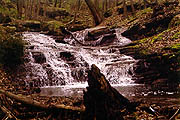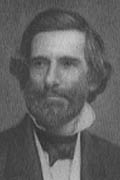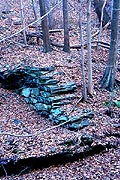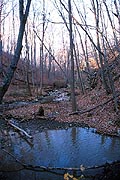|
|||
| Lawton Valley Revisited By Richard L. Champlin (Photos by W.Saslow, H.Mutter, and Raytheon)  Early in my youth this natural area in Portsmouth became a mecca for me. Besides having the usual family visits and picnics, as schoolchildren, we planned outings there, bicycling and even walking from Newport on Saturdays. The descent seventy or eighty feet to a waterfall (large-seeming then), the dripping rock ledges bordering the defile and the trees created an indelible impression. Lawton's Valley held a spell over me and here, I suspect, I became a naturalist. What would Lawton's Valley be like now, October 1992, after a half-century lapse? Early in my youth this natural area in Portsmouth became a mecca for me. Besides having the usual family visits and picnics, as schoolchildren, we planned outings there, bicycling and even walking from Newport on Saturdays. The descent seventy or eighty feet to a waterfall (large-seeming then), the dripping rock ledges bordering the defile and the trees created an indelible impression. Lawton's Valley held a spell over me and here, I suspect, I became a naturalist. What would Lawton's Valley be like now, October 1992, after a half-century lapse? I came away exhilarated that October day. True, Lawton's Valley has changed, and not necessarily for the better; one must overlook such banalities as litter and industrial castoffs. Yet. in spite of these detractions, much still remains to admire. I came away exhilarated that October day. True, Lawton's Valley has changed, and not necessarily for the better; one must overlook such banalities as litter and industrial castoffs. Yet. in spite of these detractions, much still remains to admire. Near the entrance stands the walled-in Lawton cemetary with its headstones of Job Lawton and family, dating from the early 1700's, the dark slates with head and shoulders on the top, sepulchral looking and inscribed with images of cherubs. In time past they had a curious effect on our dog, Chubby, who sniffed his way up to them, recoiled at the sight of starey-eyed images, braced his feet, barked, and was not easily called off. Indeed, he became fixed in fearful fascination. Near the entrance stands the walled-in Lawton cemetary with its headstones of Job Lawton and family, dating from the early 1700's, the dark slates with head and shoulders on the top, sepulchral looking and inscribed with images of cherubs. In time past they had a curious effect on our dog, Chubby, who sniffed his way up to them, recoiled at the sight of starey-eyed images, braced his feet, barked, and was not easily called off. Indeed, he became fixed in fearful fascination. This valley had been site of a water-powered gristmill, even in the years of Julia Ward Howe's ownership of the farm, but the millstone of those earlier years had, one guessed, long since been purloined to ornament someone's property. The falls remain, now reduced to a fraction of their former volume, and sullied with effluvium from the reservoir upstream, eastward across the West Main Road. But the cliffs of slate, rendered by the glacier steeper on the north side than on the south, are still very much intact, and drippings from the ledges gather into pools of limpid water which feed the murky brook and help to cleanse it. This valley had been site of a water-powered gristmill, even in the years of Julia Ward Howe's ownership of the farm, but the millstone of those earlier years had, one guessed, long since been purloined to ornament someone's property. The falls remain, now reduced to a fraction of their former volume, and sullied with effluvium from the reservoir upstream, eastward across the West Main Road. But the cliffs of slate, rendered by the glacier steeper on the north side than on the south, are still very much intact, and drippings from the ledges gather into pools of limpid water which feed the murky brook and help to cleanse it. Let the slates of Union Street disclose their fern fossils. Here at Lawton's Valley grow living representatives, the wood ferns in variety, the Marginal Shield Fern of rocky ledges, the Christmas Fern--so-called for staying fresh green until Christmas time--and the delicate Fragile Fern. Let the slates of Union Street disclose their fern fossils. Here at Lawton's Valley grow living representatives, the wood ferns in variety, the Marginal Shield Fern of rocky ledges, the Christmas Fern--so-called for staying fresh green until Christmas time--and the delicate Fragile Fern. Other plants of the valley include Wild Sarsaparilla (Aralia nudicaulis), and its relative Wild Spikenard (Aralia racemosa); two violets, the white Viola macloskeyi var. pallens and Viola sororia, the stemless blue violet with abnormally large leaves, one of which spreads six inches: Goutweed (Aegopodium podograria), a rampant exotic which Newport gardeners call, half in contempt. half in humor, the Newport weed: Honewort (Cryptotaenia canadensis), an infrequent plant in Rhode Island; much Clearweed (Pilea pumila); Solomon's Seal (Polygonatum pubescens); Heart-leaved Aster (Aster cordifo1ius). Other plants of the valley include Wild Sarsaparilla (Aralia nudicaulis), and its relative Wild Spikenard (Aralia racemosa); two violets, the white Viola macloskeyi var. pallens and Viola sororia, the stemless blue violet with abnormally large leaves, one of which spreads six inches: Goutweed (Aegopodium podograria), a rampant exotic which Newport gardeners call, half in contempt. half in humor, the Newport weed: Honewort (Cryptotaenia canadensis), an infrequent plant in Rhode Island; much Clearweed (Pilea pumila); Solomon's Seal (Polygonatum pubescens); Heart-leaved Aster (Aster cordifo1ius).  Blue-stemmed Goldenrod (Solidago caesia): and perhaps the most abundant of all, Beechdrops (Epifagus virginiana) which grow in countless numbers, but only under the beech trees. Most surprising of all to me was the Twisted-stemmed Goldenrod (Solidago flexicaulis) which elsewhere in Rhode Island prefers a rich, alkaline soil: its presence here says something about the soil at this site. The most eye-catching sight of all was the Jack-in-the-Pulpit with glossy vermillion seeds clustered in a tight bunch atop the stalk, the bunch 2 3/4" high by 2" wide, and consisting of 64 seeds by actual count. Blue-stemmed Goldenrod (Solidago caesia): and perhaps the most abundant of all, Beechdrops (Epifagus virginiana) which grow in countless numbers, but only under the beech trees. Most surprising of all to me was the Twisted-stemmed Goldenrod (Solidago flexicaulis) which elsewhere in Rhode Island prefers a rich, alkaline soil: its presence here says something about the soil at this site. The most eye-catching sight of all was the Jack-in-the-Pulpit with glossy vermillion seeds clustered in a tight bunch atop the stalk, the bunch 2 3/4" high by 2" wide, and consisting of 64 seeds by actual count.Trees also merit mention. A half century ago a file of European larches (Larix decidua), bordered with military precision the path leading to the valley. Those have vanished, but their successors now thrive out of formation, like a column of soldiers that has broken ranks. Other exotic trees planted in times past to decorate the entrance to the area include the Eurasian Turkey Oak (Quercus cerris), and European Beeches (Fagus sylvatica).  The presence of Sugar Maples (Acer saccharum) within the valley raises a question: have these native species escaped from cultivation outside the valley and recently returned via wind-driven seed, or have they been indigenous dwellers all along? They surely have settled in well, for one maple on the north wall has a trunk diameter just short of four feet. A large Sycamore (Platanus occidentalis) stands on low ground near the stream. Mature Silver Birches (Betula allegheniensis) and equally large Red Oaks (Quercus rubra) share the steep hillsides, along with White Ash (Fraxinus americana), Bird Cherry (Prunus avium), Silver Maple (Acer saccharinum), and White Basswood (Tilia americana). On the east shore of Aquidneck Island, at the Glen and at another ravine, grows the Bitternut Hickory (Carya cordiformis), but surprisingly this tree does not show up here. The presence of Sugar Maples (Acer saccharum) within the valley raises a question: have these native species escaped from cultivation outside the valley and recently returned via wind-driven seed, or have they been indigenous dwellers all along? They surely have settled in well, for one maple on the north wall has a trunk diameter just short of four feet. A large Sycamore (Platanus occidentalis) stands on low ground near the stream. Mature Silver Birches (Betula allegheniensis) and equally large Red Oaks (Quercus rubra) share the steep hillsides, along with White Ash (Fraxinus americana), Bird Cherry (Prunus avium), Silver Maple (Acer saccharinum), and White Basswood (Tilia americana). On the east shore of Aquidneck Island, at the Glen and at another ravine, grows the Bitternut Hickory (Carya cordiformis), but surprisingly this tree does not show up here. Certain predictable plants common elsewhere on the island did not appear in the valley proper: Poison Ivy (Toxicodendron radicans), the invasive Oriental Bittersweet (Celastrus orbivulatus), Multifloral Rose (Rosa multiflora), Japanese Honeysuckle (Lonicera japonica), and Autumn Olive (Elaeagnus umbellata). These seemed to have shunned the cool, dim, moist atmosphere of Lawton's Valley. Certain predictable plants common elsewhere on the island did not appear in the valley proper: Poison Ivy (Toxicodendron radicans), the invasive Oriental Bittersweet (Celastrus orbivulatus), Multifloral Rose (Rosa multiflora), Japanese Honeysuckle (Lonicera japonica), and Autumn Olive (Elaeagnus umbellata). These seemed to have shunned the cool, dim, moist atmosphere of Lawton's Valley. The only evidence of wildlife took the form of raccoon tracks in muddy places. Near the brook, several dark chambers formed by overhanging shales would make ideal nesting sites for water-thrushes, but for this and for the spring flora, one must return next year. Furthermore, my tramp ended where the cliffs level off. Beyond lies a pond, a swamp, and the stream flowing out into Narragansett Bay. But that's another story... The only evidence of wildlife took the form of raccoon tracks in muddy places. Near the brook, several dark chambers formed by overhanging shales would make ideal nesting sites for water-thrushes, but for this and for the spring flora, one must return next year. Furthermore, my tramp ended where the cliffs level off. Beyond lies a pond, a swamp, and the stream flowing out into Narragansett Bay. But that's another story... John Kesson, who spent his first ninety years near Lawton’s Valley, has vivid recollections of the locale. He remembers a flax mill in addition to the grist mill. Of the two, the grist mill stood nearer the falls and was powered by an overshot water-wheel; the flax mill, used for making linseed oil, by an undershot wheel. Both mills, neither in use at the time, were washed out in early spring of 1910 (he thinks) when a heavy rainstorm melted the winter’s deep accumulation of snow and ice all at once. John Kesson, who spent his first ninety years near Lawton’s Valley, has vivid recollections of the locale. He remembers a flax mill in addition to the grist mill. Of the two, the grist mill stood nearer the falls and was powered by an overshot water-wheel; the flax mill, used for making linseed oil, by an undershot wheel. Both mills, neither in use at the time, were washed out in early spring of 1910 (he thinks) when a heavy rainstorm melted the winter’s deep accumulation of snow and ice all at once. When asked if the valley was wooded in his younger days, he affirmed that it had been, so much so that in autumn, his father would go there for leaves, which he used to bank up their farmhouse foundation against winter drafts. He wouldn't go so far as to say what kinds of trees. When asked if the valley was wooded in his younger days, he affirmed that it had been, so much so that in autumn, his father would go there for leaves, which he used to bank up their farmhouse foundation against winter drafts. He wouldn't go so far as to say what kinds of trees.Several of the species mentioned above raise questions. I saw just one basswood in the valley: how came it here? Has this species grown here continuously since before human encroachment? The Silver Maple might easily have come from seed of a cultivated tree outside the valley, yet it grows exactly where it would be found in the wild, at the very edge of the brook, as if it and its progenitors had maintained themselves there since prehistoric times. The Bird Cherry is clearly known to have been introduced. Pleasing though this visit had been, finding primitive nature so close to centuries-old civilization, the question kept recurring to me. Have the wild species of plants here survived continuously in spite of human settlement? Or have they somehow returned to the site, each to its appropriate habitat? My considered guess is that even during the period of cultivation a few plants of each native species have persisted, and because of recent human neglect of the land, have once more begun to multiply. It suggests that in the long run nature wins out. Richard Champlin is a retired librarian of the Redwood Library in Newport, and has botanized throughout Rhode Island for many years. He has written over sixty articles on historical and natural subjects, and is the author of Trees of Newport (Preservation Society of Newport County, 1976), and with Dr. George Church co-authored Rare and endangered vascular plant species in Rhode Island (New England botanical Club and U. S. Fish & Wildlife Service, 1978). This article originally appeared in the March 1993 Edition of the Rhode Island Wild Plant Society Newsletter and appears here by permission. |
 Lawton Falls Closeup © 2000, W. Saslow
Rock Outcropping © 1999, W. Saslow  Waterfall at Lawton Valley Today © 2000, W. Saslow  Samuel G. Howe, circa 1859, from a photograph by Black
|
| [Search!] | [Survey] [Planning] [Projects] [Outreach] | [What's New!] |
|
Copyright © 1999-2002, REWHC. All Rights Reserved 599 have visited |
||




